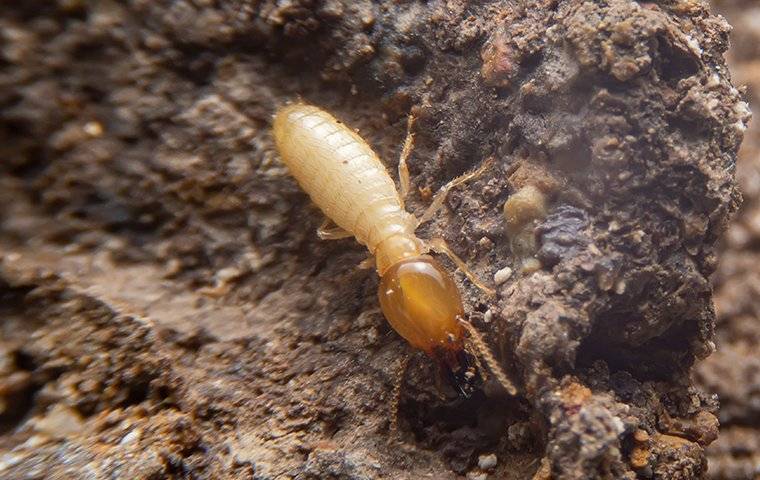
Tackling A Termite Control Problem In Greensboro
One of the most difficult aspects of dealing with subterranean termites in Greensboro is that these are secretive insects. You can have a million termites on your property and not know it. We're not saying you do; we're just saying that it is possible. The first step in tackling a termite problem is detecting them. Detection is an ongoing process of watching for signs of active termites in your yard. It is also necessary to perform a detailed inspection of your property at least once a year. When you find termites, the next step is to decide what to do about them. It is amazing how often property owners ignore termites, even though they know they shouldn't. There are many reasons. Perhaps the most important reason is that signs of termites in the yard are often subtle. You may find a handful on a dead branch and think that the termites will just pass through your property or that they'll stay in your yard and not get into your home to feed on pressure-treated wood. Both of these are common misconceptions. Termites don't pass by. They establish nests, grow their populations, and establish more nests nearby. As for pressure-treated wood, water damage can compromise protected wood and allow termites to get inside—not to mention that many homes have wood that isn't pressure-treated. Join us as we discuss how to find signs of termites in your home and yard, how to identify termite damage, and how to avoid termite damage. If you already know how to detect termites and you need termite pest control in Greensboro, navigate to our contact page for service. We'll help you find the right option for your family and your property.

What Do Termites Look Like?
All termites begin life as workers. The workers are the only termites that damage wood. Unfortunately, workers are the most plentiful type of termite in a colony by a significant margin. But, as plentiful as they are, they are the most difficult of all termites to detect. Worker termites hide from the light and avoid coming out into the air. The first reason why this is so is fairly straightforward. Workers don't like the light. The second is more subtle. Workers have thin skin, and dry conditions can dehydrate them, so they live almost exclusively in utter darkness in the moist confines of their mud-lined tunnels. In most cases, you'll have to remodel part of your home or dig a hole in your yard to find these little guys. If you do, here are some physical traits to help you identify them.
- Termite workers look like fat ants. While they have three body parts, like an ant, they don't have a pinch at the waist.
- Termite workers are pale to yellowish in color and about ⅛ of an inch long.
- You'll find workers near decaying wood, soil, and mud. If you pick up a dead branch and see little pale-colored bugs, don't ignore them. Those are definitely worker termites.
While worker termites are hard to detect, termite swarmers are not. When needed, the queen of a termite colony causes workers to develop into reproductives. Some reproductives have no wings and remain inside the ground. Swarmers grow wings and exit the nest. The job of termite swarmers is to make new nests, so they get busy selecting mates, shedding their wings, and going back into the ground. It is critical to understand this because, while they're much more noticeable than workers, you're not likely to see swarmers for long. The mating process takes less than an hour. If you are "fortunate" to see termite swarmers on your property, here are a few traits to help you identify them.
- Eastern subterranean termite swarmers are black with white wings. In Greensboro, these are the termites we battle.
- A termite swarmer is a mere ⅜ of an inch in length. You can have one of these little insects land on your skin while you're in your backyard and not even realize it is a swarmer. The world is filled with flying insects.
- The wings of a termite swarmer stack on top of each other. Unlike an ant's wings, there is no cleft. The wings of a termite swarmer are rounded at the tips and look like a stretched-out teardrop shape.
- If you find a group of swarmers together, you will immediately notice their white wings. The wings are much larger than their tiny bodies.
There are a few other kinds of termites in a colony. Soldiers are larger than the workers and have black pincers on their orange heads. They hang out with the workers, so you'll see them if you uncover worker termites. The king and queen of a colony (which were once swarmers) stay hidden deep in the heart of their colony. You'll never see them, so you don't need to know how to identify them.
Primarily, the workers and the swarmers are the two types of termites you're looking for on your property. Keep watch for them in your yard and home. Along with this, perform routine inspections to detect them. Catching termites early is the secret to avoiding termite damage.
Most of the time, you won't see a single termite. You'll have to look for other warning signs, such as termite damage. Let's take a moment to discuss what termite damage might look like and where you might find it.
What Is The Best Way To Identify Termite Damage?
Termites aren't the only pests that can damage the wood in your Greensboro home. Carpenter ants, wood-boring beetles, carpenter bees, mice, rats, and other pests can also damage wood. Some wood damage isn't even the result of pest problems. Spores in the air can land on damp wood and break down wood, over time. How can you tell that termites are the culprits? Sometimes you can't, but if you understand how termites behave, you may unravel the mystery.
Termite damage is often associated with mud. The reason is that the skin of a worker termite is thin and requires moisture. When worker termites make their tunnels, they bring soil up into their tunnels from the ground. The soil is mixed with saliva, and mud is created. The mud is used to line tunnel walls. So, if you find exposed tunnels with visible mud (or they feel gritty to the touch), you have a termite infestation. If the tunnels feel smooth, carpenter ants are the pests you're dealing with in your home.
Most of the time, you won't see termite damage, but you can still detect termites by looking for mud. Workers use mud to patch breaches in tunnel walls and also to create shelter tubes from the ground up the sides of structures.
Is There Way To Prevent Termites For Good?
Yes. There is a way to completely protect your property from termite damage. You can have a liquid termiticide barrier installed all the way around your property, which requires drilling and trenching, or you can have bait stations installed. The on-staff experts at Go-Forth Home Services prefer bait, and specifically, the Sentricon® System with Always Active™. Sentricon® is field-tested, highly researched, and backed by a termite damage warranty. It is also a professional-grade termite control product installed by certified technicians. When the Sentricon® System is installed around your property, you can sleep at night. Here are a few reasons why.
- Termites never stop. They are active 24 hours a day, 365 days a year. Sentricon® doesn't stop either. It is always actively protecting your property from termites.
- Termites keep looking for food, even after they've found a food source. Since they do this, they always find the bait. It has been scientifically proven.
- Termites have a preference for cellulose that is easily broken down. The bait in Sentricon® is designed to appeal to termites and was found to be more interesting to termites than wood during testing.
- Termiticides wear out, over time, but Sentricon® bait becomes more appetizing to termites the longer it ages. As long as your system is monitored and maintained, its effectiveness will increase with time.
- The Sentricon® System does not require drilling and trenching and has no odor. It sits in the ground, waiting for termite workers to collect the active ingredient and share it with the other termites in their colonies.
- Sentricon® targets termites by preventing the molting process. When termites can't molt, they are eliminated.
There is no better way to prevent termite damage for good than to have Sentricon® installed. Seek out a Certified Sentricon® Installer in your area. No other termite bait has proven as successful as Sentricon®, and the advantages over liquid termiticides are substantial.
Professional Termite Control In Greensboro
Contact Go-Forth Home Services for termite prevention, monitoring, and colony elimination if you're in Greensboro. Our Certified Sentricon® installers can put your termite protection in place and maintain your pest control system so that termites never make a meal out of your home.
Give us a call or drop us a line. We're always standing ready to help you with all your pest concerns.
Customer Reviews
-
“He spent time educating us about "pests" and provided information regarding services with GoForth.”- Joyce C.
-
“Texted me before coming. Worked with me playing musical rooms with my dogs. I'll see how things are.”- Constance E.
-
“Amazing response time, reasonable prices, great customer service. Tevin was thorough and confident in his plan to fix our horrendous fire ant problem. We have had negative experiences with prior exterminators and probably waited way too long to call Go-For”- Ashley T.
-
“- Toya B.
We have been customers for almost 7 years for a reason. Our technician is the best. He always knows exactly how to address whatever pest has decided to bother us. We have referred them to many of our neighbors. Well worth the cost not to have to worry a
” -
“Answered all my questions and I felt their pricing was very reasonable.”- Deborah J.
-
“Brian went above and beyond what was expected, and I hope I get him again as my technician for future services!”- Tam L.
-
“He was thorough with inspecting and treating our home, which I really appreciate, and he took the time to answer my many questions.”- Jasmine B.
-
“Love the detailed summary and pics of what he did and saw! And did I mention how wonderful Olivia was to get us all set up?!!”- Beechy A.


Over the years, we’ve boiled down our mission to a core set of values:
-
Give A CrapDelight others by owning your role and saying yes. Take pride in how you appear & act & every other detail of the job. Be on time, attentive, & enthusiastic. Act as if the buck stops with you on every aspect of the job.
-
Chase PerfectionChase Perfection, knowing full well we will not reach it, but along the way we will catch excellence. Have a sense of urgency; Go-Forth Time - right now might be the only time you have to get it right.
-
Dig Deeper
Be an action-oriented professional that makes decisions based on evidence rather than stories & assumptions. Stay curious. Data can speak for itself.
Understand the cause of the fire rather than rushing to extinguish it.
-
Fight For SimplicityKeep it simple & consistent. Focus on how things should be done every time.
-
Face It, Fix ItConfront challenges directly and address issues head-on. A bias for action and powerful conversations drive our progress. It’s about getting it right rather than being right.
-
Grow!Growth is our purpose. Growing as people & growing our business.